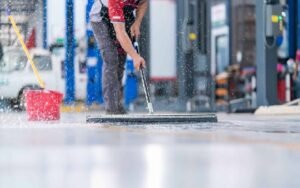Environmental implications of vinyl flooring production
3 min read
vinyl flooring
Vinyl flooring has acquired gigantic ubiquity lately because of its sturdiness, reasonableness, and flexibility in plan. Notwithstanding, underneath its gleaming surface lies an assembling interaction that raises huge natural worries. From the extraction of unrefined substances to the removal of waste, vinyl flooring production leaves a considerable carbon footprint and poses numerous environmental challenges.
1. Raw Material Extraction:
The essential unrefined substance for vinyl flooring is polyvinyl chloride (PVC), a manufactured plastic got from non-renewable energy sources, principally oil or gaseous petrol. The extraction of these non-inexhaustible assets adds to environment obliteration, water contamination, and ozone harming substance emanations. Moreover, the development of PVC includes the arrival of poisonous synthetic substances like dioxins and phthalates, which present serious wellbeing dangers to the two people and untamed Eid Gifts.
2. Energy Consumption:
The assembling system of vinyl flooring is energy-serious, requiring significant measures of power and intensity. From the development of PVC gum to the blending of added substances and the arrangement of sheets or tiles, each stage requests critical energy inputs, dominatingly obtained from petroleum products. This dependence on non-environmentally friendly power worsens environmental change and exhausts limited assets.
3. Emissions and Pollution:
During the development of vinyl flooring, different poisons are delivered into the air, soil, and streams. These incorporate unpredictable natural mixtures (VOCs), which add to air contamination and indoor air quality issues. Furthermore, the removal of assembling side-effects and wastewater containing weighty metals and other hurtful substances can sully soil and water sources, presenting dangers to biological systems and human wellbeing.
4. Waste Generation:
Vinyl flooring creation produces significant measures of waste at different stages, including offcuts, decorations, and faulty items. Removal of this waste presents a critical ecological test, as PVC isn’t biodegradable and can continue in that frame of mind for many years. Burning of vinyl squander discharges harmful synthetic substances out of sight, while landfilling adds to soil and groundwater tainting.
5. End-of-Life Disposal:
Vinyl flooring creation produces significant measures of waste at different stages, including offcuts, decorations, and faulty items. Removal of this waste presents a critical ecological test, as PVC isn’t biodegradable and can continue in that frame of mind for many years. Burning of vinyl squander discharges harmful synthetic substances out of sight, while landfilling adds to soil and groundwater tainting. This underscores the need for responsible disposition in real estate to address these environmental challenges effectively.
6. Health Concerns:
Notwithstanding ecological effects, vinyl flooring creation raises worries about human wellbeing. Openness to phthalates, which are usually utilized as plasticizers in PVC, has been connected to respiratory issues, formative issues, and chemical disturbance. Besides, the arrival of VOCs from vinyl deck can add to indoor air contamination, possibly causing respiratory sicknesses and worsening existing medical issue.
Conclusion:
While vinyl flooring offers durability and affordability, its creation accompanies huge natural expenses. From the extraction of petroleum products and the emanation of poisons to squander age and wellbeing gambles, the lifecycle of vinyl flooring represents various difficulties to supportability. As buyers and producers progressively focus on ecological obligation, there is a developing requirement for options that limit the natural effect of deck materials. By putting resources into exploration and development, as well as advancing feasible practices all through the inventory network, the deck business can make progress toward relieving its natural impression and encouraging a more maintainable future.






